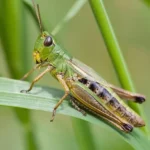
Skinks are the world’s second largest lizard group (geckos are the largest). Except for the boreal and polar regions, they can be found all over the world. So far, 1200 skink species have been described. They can be found in a variety of habitats, including grasslands, forests, mountains, savannas, deserts, and cities. Skinks of various species can be found in the gardens as part of the regular fauna. Certain skink species are popular as pets. Some skinks, such as the androgynous skink, are threatened.
The size of a skink varies depending on the species. Smaller species are typically 3 inches long, while larger species can grow to be 14 inches long.
Skinks are frequently confused with snakes due to their short neck, small legs, and snake-like body movement.
The skink’s body color is similar to that of its surroundings. They can easily blend in with their surroundings and hide from predators if they remain motionless.
Skinks have a plethora of natural enemies due to their small size. Skinks’ main predators include cats, dogs, foxes, raccoons, snakes, large lizards, and birds of prey.
Skinks can survive in a variety of climates by adopting various lifestyles. The majority of species are arboreal (live in trees), but some are terrestrial (live on the ground) or aquatic (spend their life near or in the water).
Skinks enjoy basking on the rocks during the day because they are cold-blooded animals.
The majority of skinks are diurnal (active during the day). Cockroaches, caterpillars, beetles, and grasshoppers are their primary food sources. Skinks of larger sizes will hunt smaller rodents, snails, slugs, and other lizards. Plants (in a lesser proportion) are also part of their normal diet.
Skinks are regarded as valuable lizards that clean gardens of pests due to their insect-oriented diet.
Skinks do not have to eat every day, but when food is available, they will not pass up the opportunity to fill their stomachs.
Green blood is found in certain skinks. The distinctive color of the blood is caused by an accumulation of biliverdin, a green bile pigment.
Skinks, like most lizards, can detach their tails in times of danger. The tail will re-grow to its original size. This process can take a long time and requires a lot of energy.
Skinks are territorial animals that will stand in front of their nests to protect them.
Some skink species give birth to live babies, while others lay eggs.
Egg-laying species typically have 10 to 30 eggs. The hatching period lasts about a month. Skinks do not show parental affection. Young skinks are left alone from the time they are born or hatch.
The average lifespan of a skink can range from 5 to 20 years depending on the species.









